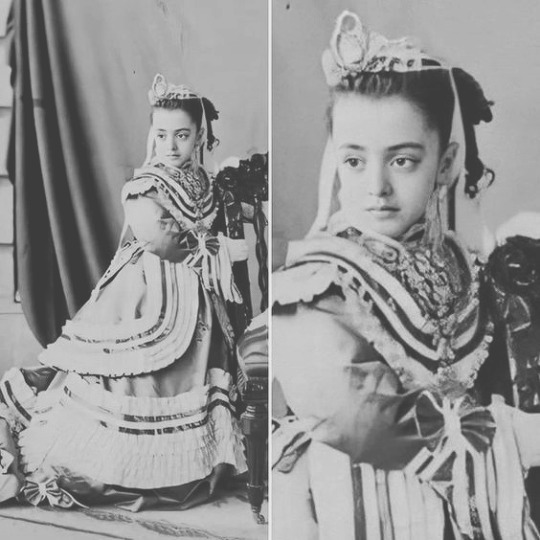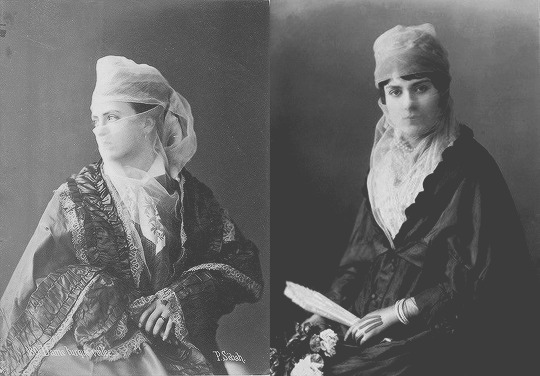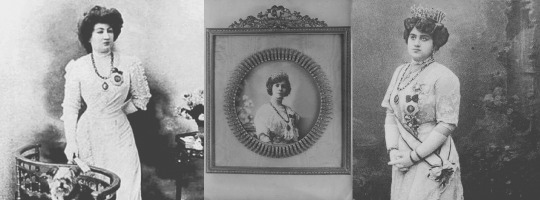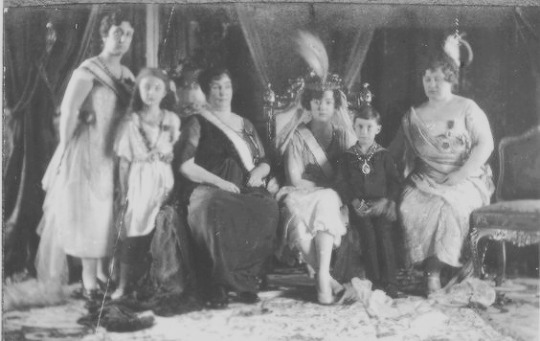#nazima sultan daughter of abdulaziz
Note
I have a lot of interest rest in Ottomans. How fashion changed after 1860s in Ottoman women? Ottoman fashion which is shown in Payitaht Abdulhamid in 1890s, was it real? Please explain with pictures
I am sorry for the long wait, I had internet connection problems.
After 1860s is a very specific time but I'll do my best. We can't forget that talking about fashion in a setting like the Ottoman empire is way more difficult because women weren't supposed to be portrayed or photographed so the material is scarce.
It was after the visit of the Empress Eugénie that the women of the palace and the wives of the high functionaries copied as nearly as they could the appearance of the beautiful Empress. They divided their hair in the middle, and spent hours in making little bunches of curls. High-heeled shoes replaced the coloured babouches [slippers]; they even adopted the hideous crinolines and abandoned forever those charming Oriental garments, the chalvar and the entari which they considered symbols of servitude, but which no other fashion has been able to equal in beauty — Zeynoub Hanoum, A Turkish Woman’s European Impressions
The chalvar, called şalvar in Turkish are the characteristic baggy pants that women (and men too) would wear underneath their several layers of clothing. The entari was worn over the undergarments and the şalvar:

These are all XIX century entari.
In any case, rich women began to abandon these clothes for more European ones especially after the visit of Empress Eugénie in Istanbul. This can be seen clearly in children's fashion:

Nazima Sultan in 1876 and Naime Sultan in 1882

Saliha Sultan in the 1870s
In this period [1867], the young ladies and young girls had completely abandoned the old dresses with three tails or trains and the baggy pants underneath; fashion now demanded shirts with a single train which was caught up and attached to the belt – there were now petticoats instead of şalvars or the baggy pants previously worn. The headdresses had also changed with the times and now usually matched the costumes; there were earrings with jewels, medallions and elaborate hairstyles, garnished with precious stones. — Leyla (Saz) Hanımefendi, The Imperial Harem of the Sultans. Daily Life at the Çıragan Palace During the Nineteenth Century
As for outerwear:
Women changed the thicker cloth they had traditionally used for their feraces (long flowing outer garments) for a much thinner material. They changed their yellow boots of morocco leather for shoes with trimmings of imitation gold thread, which they wore with thin, white socks. They began to use thinner veils and they turned covering themselves into a method for making themselves more alluring, a trend appreciated by Ali Rıza Bey, who commented that ‘the veils of our women, which were a means of ornamenting the face rather than concealing it, became finer. How charming the colourful feraces looked! And these finer veils were unable to obscure the beauty [behind]’. — Ebru Boyar, Kate Fleet - A Social History of Ottoman Istanbul

These photographs are great examples of just how fine veils had become. They basically did not hide any feature and this was a problem for conservatives (and sultans as well):
The çarşafs had become merely ordinary dresses, the feraces had turned into sleeveless capes, the veils had become too thin. [Abdülhamid II] issued an order that this should not occur. Further, women were not to wear coats or short, tight-waisted jackets which imitated military styles — Ebru Boyar, Kate Fleet - A Social History of Ottoman Istanbul

In the photograph above you can see a western dress underneath the ferace and several rows of what seem to be pearls.
In the XIX century, women (especially wealthy women of course) began to go out more, especially to pleasure gardens or at the Bosphorus shore. This meant that new accessories began to be used, among them the parasol. As pleasure gardens (ie. parks) were public places, men and women could see each other in these occasions:
A parasol in the rowing boat! It explains what the person wants to say. For example, if it is bent a little to one side, it means ‘I am annoyed with you’, if it is bent over further, ‘I am really angry’, if it completely covers the face, it means ‘you will not see my face again’, ‘I don’t want to see you, have you still not understood?’, if it swings hard from right to left, it signifies ‘don’t stay, pass by’, ‘return, go’, if it falls slightly to the front, it is in the place of a greeting, ‘welcome, sir’, if it falls a lot, ‘my heart has beaten again’, if it goes to the back, it means ‘oh!’, if it leans all the way over backwards, ‘what a state I am in, see me and have pity!’, if it is held to the side, ‘oh, how fine, what happiness this is!’, if it is opened and closed, it means ‘not tonight, tomorrow’, if it is closed and stays so, ‘we will make an appointment for the following day — Ebru Boyar, Kate Fleet - A Social History of Ottoman Istanbul
Men too had secret gestures:
making signs with the eyes and eyebrows, winking one eye, making as if wiping your face with a handkerchief, smelling the handkerchief with which you have just wiped your face, sighing deeply, and placing your hand over your heart. Placing your hand on your temple and half-closing then closing your eyes means ‘I am dying for you’, unbuttoning of one or two buttons of the waistcoat means ‘my heart is palpitating, I cannot bear this beating’. If you have a cigarette in your mouth, even if it is newly lit, and you take it from the corner of your mouth and hurl it away, this is because women do not like addiction to tobacco any more than its smell. To call over a beggar and give him a few coins demonstrates your compassion and generosity. To be busy looking at the posters outside Manakyan’s theatre is a sign of liking romantic themes such as La Dame aux camelias or Countess Sara. — Sermet Muhtar Alus, 30 Sene Evvel İstanbul. 1900’lü Yılların Başlarında Şehir Hayatı
... clothing made in European fashion, top hats, fancy canes, pet dogs, piano lessons, French language lessons, operas, dances, and balls, to the eventual employment of Western literary forms such as the novel, short story, and newspaper and the print culture it introduced, which had profound effects in creating new visions of Ottoman society and the individuals living within it. These literary forms constructed a new image of an Ottoman as a refined man "introverted, very sensitive, knowledgeable in Western music and literature, conversant in a Western language, positivist, attributing value to human beings, and subscribing to a Western style of life" — Fatma Müge Göçek, Rise of the Bourgeoisie, Demise of Empire; Ottoman Westernization and Social Change
Of course the same craze invested the Palace. Sisters Fatma and Mediha are clearly wearing European gowns and accessories:

Fatma Sultan around 1870 and Mediha Sultan in 1888
In the photograph below we can see Refia Sultan dressed exactly like a European woman in 1865. 1865 is very early but she was very interested in everything that came from Europe.

I was not able to identify these people but they're clearly from the Ottoman empire:

the lady is particularly interesting because not only is she wearing a European-style tiara but she seems to be also wearing the Order of the Charity (the white sash) 1st class, which was usually awarded to princesses.
Here we have sisters Hatice, Fehime and Fatma (all daughters of Murad V). The European style of their clothes and accessories is pretty evident.


Rukiye Sabiha Sultan on her wedding day in 1921

other photo of Rukiye Sabiha Sultan’s wedding
So... yeah, by the fall of the empire clothes were completely European.
#anon#ask post#ask: ottoman history#ottoman fashion#ottoman photos#late ottoman empire#nazima sultan daughter of abdulaziz#naime sultan daughter of abdulhamid ii#saliha sultan daughter of abdulaziz#fatma sultan daughter of abdulmecid i#mediha sultan daughter of abdulmecid i#refia sultan daughter of abdulmecid i#hatice sultan daughter of murad v#fehime sultan daughter of murad v#fatma sultan daughter of murad v#rukiye sabiha sultan daughter of mehmed vi
195 notes
·
View notes
Note
In the book Neslishah: The last Ottoman princess, Neslishah tells that Nazime Sultan, Abdulmejid II's elder sister was alive at that time and gifted her a bracelet, on account of her wedding, so I think 1947 is more accurate as her death date, But Sakaoğlu says it was 1895, so you think 1947 is right?
Yes, 1947 is the right year. Neslişah is a better source than Sakaoğlu or Öztuna.
7 notes
·
View notes
Text
Sultân Abdülazîz + family
Consorts:
Dürr-i Nev Başkadınefendi (15.3.1835-4.12.1895): born Princess Melek Dziapş-lpa, she was the daughter of Prince Mahmud Bey Dziapş-lpa and Princess Halime Hanım. She was the eldest of three sisters and entered palace service with her younger sister Princess Ayşe Kemalifer. She became a lady of Servetseza Kadınefendi and received a good education: she was a good pianist and could speak French without an accent. She also made some paintings which she later gave to Bezmialem Valide Sultan and Servetseza Kadınefendi. Dürrinev had long blonde hair and hazel eyes; when the future Sultan Abdülaziz first saw her, he immediately asked Servetseza Kadınefendi to let him marry his lady-in-waiting. The wedding took place on 20 May 1856 in Dolmabahçe Palace; a year later she gave birth to Yûsuf İzzeddîn Efendi (1857-1916), then to Saliha Sultan (1862-1941). After Abdülaziz's dethronement, she was imprisoned in Feriye Palace in the apartments above his. She fainted when she saw his corpse. She died on 4 December 1895 and was buried in the mausoleum of Mahmud II.
Edâ-dil Kadınefendi (1845?-1875): Second Imperial Consort, she was Abkhazian and was the daughter of Prince Aredba Tandal Bey. She entered palace service at a young age, where she was especially liked by Pertevniyal Valide Sultan. Edadil was given to Sultan Abdülaziz as a gift for his accession to the throne. She was said to be beautiful, with blue eyes and brown hair. She was the mother of Mahmûd Celâleddîn Efendi (1862-1888) and Emine Sultan (1866-1867). The sudden death of her brother affected her a lot and she died young in 1875. She was buried in the mausoleum of Mahmud II.
Hayrân-ı Dil Kadınefendi (1846-1895): Second Imperial Consort after the death of Edâ-dil Kadınefendi. There is no certain information about her background and family, nor how she entered palace service before becoming a consort. She married Sultan Abdülaziz on 21 September 1865, a year later she gave birth to Nazime Sultan (1866-1895/1947) and then to Caliph Abdülmecid II (1868-1944). After the deposition of Murad V, she was allowed to retire to Ortaköy Palace. She died on 26 November 1895 and was buried in the mausoleum of Mahmud II.
Neşerek Kadınefendi (1848-1876): Third Imperial Consort, she was most probably Caucasian and born in Sochi to Prince İsmail Bey Zevş-Barakay. She married Sultan Abdülaziz in 1868. She was the mother of Mehmed Şevket Efendi (1872-1899) and of Emine Sultan (1874-1920). She died on 11 June 1876 and was buried in the Yeni Mosque.
Gevheri Kadınefendi (1856-1884): Fourth Imperial Consort, she was the mother of Esma Sultan (1873-1899) and Mehmed Seyfeddin Efendi (1874-1927). Her real name was Enime, her father was Salih Bey and her mother was the daughter of Prince Tsanba Osman Bey. She had long curly auburn hair and blue eyes. She always wore white dresses and a light blue veil on her head; her only jewelry were the rings Abdülaziz gave her on their wedding day in 1872. Gevheri was a very charitable women: she helped the poor however she could, paid for the education of young orphans and even supplied funds to repair several mosques and schools. She died in Ortaköy Palace on 6 September 1884 and was buried in the Yeni Mosque.
Children
Şehzade Yûsuf İzzeddîn Efendi (11.10.1857-1.2.1916): Abdülazîz's eldest child, he was kept secret in Kadri Bey's villa in Eyüp until his accession to the throne in 1861. He was considered the true heir to the throne by his father, who tried throughout his reign to change the line of succession to primogeniture. Izzeddin travelled to Europe with his father at 10 years old and later, in 1910, represented the Ottoman Dynasty at the funeral of Edward VII of the United Kingdom. He had five consorts and four children: Șehzade Mehmed Bahaeddin (2.1883 - 8.11.1883), Hatice Şükriye Sultan (24.2.1906 - 1.4.1972), Șehzade Mehmed Nizameddin (18.12.1908-19.3.1933) and Mihriban Mihrişah Sultan (30.8.1916 -25.1.1987)
Saliha Sultan (10.8.1862-1941): Şehzade Izzeddin's full-sister. She was born in Dolmabahçe Palace. At the age of 13, she was engaged to the son of the Khedive of Egypt, but Abdulhamid II broke the engagement, and Saliha Sultan had to wait 13 more years before getting married. In 1889 she married Ahmed Zülküf Bey (later Paşa), who was said to have been very handsome. Their only child was Kâmile Hanım-Sultân (1890-1896). She moved to Egypt after the Dynasty was exiled and died in poverty at the age of eighty.
Şehzade Mahmud Celaleddin Efendi (14.11.1862-1.9.1888): he was Vice Admiral of the Imperial Army, a pianist and a flautist. His aunt Adile Sultan, a renowned poet, wrote several compositions to celebrate him.
Nazima Sultan (25.2.1866-1895/1947): daughter of Second Imperial Consort Hayrân-ı Dil Kadınefendi, she studied French in childhood. She married Dâmâd Alî Hâlid Paşâ on 20 April 1889. While Öztuna claims that she died in 1947, Sakaoğlu believes that his source, N. S. Örik, mistook Nazima for her elder sister Saliha.
Şehzade Mehmed Selim Efendi (28.10.1866-21.10.1867): buried in the mausoleum of Mahmud II
Emine Sultan (30.11.1866-23.1.1867): buried in the mausoleum of Mahmud II
Caliph Abdülmecid II (29.5.1868-23.8.1944): younger child of Second Imperial Consort Hayrân-ı Dil Kadınefendi, he was the last Caliph of the Ottoman Empire.
Şehzade Mehmed Şevket Efendi (5.6.1872-22.10.1899): son of Third Imperial Consort Neşerek Kadınefendi, he was only 4 years old when he lost his father so he grew very close to his uncle Abdülhamîd II, who took him to Yildiz Palace and raised him alongside his sons. He was married to Fatma Rûy-i Nâz Hanımefendi and had a son, Mehmed Cemâleddîn Efendi (1891-1947).
Esma Sultan (21.3.1873-7.5.1899): daughter of Fourth Imperial Consort Gevheri Kadınefendi, according to Alderson she was instead daughter of Neşerek Kadınefendi. As she had lost her father at the age of three, she grew up in the household of her eldest brother Şehzade Yûsuf İzzeddîn Efendi. She was very beautiful: tall, slim, with black eyes and very white skin. On 20 April 1889 she married Dâmâd Kabasakal Çerkes Mehmed Paşa, 20 years her senior and previously the husband of her aunt Naile Sultan. She had five children: Sultân-zâde Hasan Bedreddîn Beyefendi (1890-29.1.1909), Sultân-zâde Hayreddîn Beyefendi (1892-1987), Mihribân Hanım-Sultân (1894-1894), Sultân-zâde Sâ'deddîn Beyefendi (14.6.1895-1970s) and Sultân-zâde 'Abdullâh Beyefendi (1899-stillborn). Esma Sultan died after delivering her fourth son and fifth child.
Fatma Sultan (1874-1875): buried in the mausoleum of Mahmud II
Emine Sultan (24.8.1874-29.1.1920): daughter of Neşerek Kadınefendi, she was raised in the household of her eldest brother Şehzade Yûsuf İzzeddîn Efendi. She married Dâmâd Mehmed Şerif "Çavdaroğlu" Paşa in 1901 and had a daughter with him, Hamide Hanım-Sultân, who died in infancy.
Şehzade Mehmed Seyfeddîn Efendi (22.9.1874-19.10.1927): Vice Admiral of the Ottoman army, he was a great musician, a student of Callisto Guatelli. In 1914 he bought the organ from the Chapelle St. Louis and had it brought to Istanbul. He had two consorts and four children: Şehzade Mehmed Abdülazîz Efendi (1901-1977), Şehzade Mahmud Sevket Efendi (1903-1973), Şehzade Ahmed Tevhid Efendi (1904-1966) and Fatma Gevheri Sultan (1904-1980)
Münire Sultan (1877): posthumous child, she died in infancy.
#history#ottoman history#Abdulaziz#*consortsandchildren#durrinev kadin#edadil kadin#hayranidil kadin#neserek kadin#gevheri kadin#sehzade yusuf izzeddin son of abdulaziz#saliha sultan daughter of abdulaziz#nazima sultan daughter of abdulaziz#esma sultan daughter of abdulaziz#emine sultan daughter of abdulaziz#sehzade mahmud celaleddin son of abdulaziz#abdulmecid ii#sehzade mehmed sevket son of abdulaziz#sehzade mehmed seyfeddin son of abdulaziz
18 notes
·
View notes
Note
Hello,could you list some of Mahmud ll’s granddaughters.
Hello! I have listed all the granddaughters in case someone else wants to know about more of them.
by Saliha Sultan:
Ayşe Sıdıka Hanımsultan (1821 – 1886), who married Server Paşa, son of Saîd Server Efendi.
by Atiye Sultan:
Seniyye Hanımsultan (3.10.1843 – 10.12.1910), who married Hüseyin Hüsnî Paşa, son of Sırkâtibizâde Mustafa Paşa.
Feride Hanımsultan (30.5.1847 – 1.1913), who married Mahmûd Nedîm Paşa and, with him, had Mehmed Sâib Bey (1861 – 28.11.1871)
by Adile Sultan:
Sıdıka Hanımsultan, died in infancy
Aliyye Hanımsultan, died in infancy
Hayriye Hanım-Sultân (6.1846 – 26.7.1869), who married Ahmed Rifat Bey later Paşa
by Sultan Abdülmecid:
Mevhibe Sultan (9/31.5.1840 - 3.11.1840/9.2.1841), daughter of Huşyar Kadınefendi
Naime Sultan (11.10.1840 - 1.5.1843), daughter of Tirimüjgan Kadınefendi and thus full sister of Abdülhamid II.
Fatma Sultan (1.11.1840 - 26.8.1884), daughter of Gülcemal Kadınefendi and thus full sister of Refia Sultan and Sultan Mehmed V Reşad. She firstly married Galib Paşa, who drowned at sea, and secondly Mehmed Nuri Paşa, with whom she had: Mehmed Fuad (1859-1862) and Emine Lutfiye Hanımsultan (1863-1866)
Behiye Sultan (22.2.1841 - 3.6.1847) her mother is listed as the Second Ikbal but no name was given.
Neyyire Sultan (13.10.1841 - 14.1.1844)
Hatice (?) Refia Sultan (7.2.1842 - 4.1.1880), daughter of Gülcemal Kadınefendi, she married Mahmud Edhem Bey (son of the above mentioned Adile Sultan's husband Mehmed Ali Paşa, from a previous wife)
Aliyye Sultan (20.10.1842 - 23.7.1844/10.7.1845), possibly daughter of Şevkefza, later Valide Sultan, and thus full sister of Murad V
Cemile Sultan (17.8.1843 - 26.2.1915), daughter of Düzdidil Kadınefendi, she married Mahmud Celaleddin Bey later Paşa with whom she had: Fethiye Hanımsultan (1887-1915), Fatıma Hanımsultan (1890-1901), Sakıp Bey (1897-1930), Mehmed Celaleddin Bey (maybe twin of Sakıp Bey, 1897-1916)
Münire Sultan (9.12.1844 - 29.6.1862), daughter of Verdicanan Kadınefendi, she married firstly İbrahim İlhami Paşa and secondly Ferik (lieutenant general) İbrahim Paşa
Samiye Sultan (23.2.1845 - 15.4.1845)
Nazime Sultan (26.11.1847 - 1.12.1847)
Sabiha Sultan (15.4.1848 - 27.4.1849), daughter of Mahitab Hanım
Behice Sultan (26.8.1848 - 30.11.1876), daughter of Nesrin Hamın, she married Halil Hamid Paşazade Hamid Bey but died only 14 days after the wedding.
Mukbile Sultan (9.2.1850 - 25.2.1850), daughter of the Fourth Ikbal, no name was given.
Seniha Sultan (5.12.1851 - 15.9.1931), daughter of Nalandil Hanım, she married Mahmud Celaleddin Paşa, with whom she had: "Prince" Sabahaddin Bey (1877-1948) and Sultanzade Lütfullah Bey (1880-1973). Sabahaddin Bey was called "the Prince" in Europe.
Zekiye Sultan (26.1.1855 - 19.2.1856), twin sister of Fehime Sultan
Fehime Sultan (26.1.1855 - 10.11.1856), twin sister of Zekiye Sultan
Şehime Sultan (1.3.1855 - 21.5.1857), daughter of Senior Ikbal Nalandil.
Mediha Sultan (30.7.1856 - 7/9.11.1928), daughter of Gülistu Hamın and thus full sister of Mehmed VI Vahideddin. She married firstly Sami Paşa-zade Necip Bey later Paşa and secondly Damat Ferid Paşa.
Naile Sultan (30.9.1856 - 7/18.1.1882), daughter of Şayeste Hanım, she married Kabasakal Çerkes Mehmed Paşa but died at the age of 25.
Bedia/Bedihe Sultan (30.9.1857 - 12.7.1858), daughter of Serfiraz Hanım
By Sultan Abdülaziz:
Saliha Sultan (10.8.1862 - 1941?), daughter of Dürrinev Başkadınefendi and younger sister of Şehzade Yusuf İzzeddin Efendi. "She was engaged to a son of Khedive Ismail of Egypt, but the engagement was broken off after her father’s deposal and in April 1889 she married Ahmed Zülküfil Paşa". Her only child was Kâmile Hanım Sultan, who died in 1896.
Nazima Sultan (26.2.1866 - 26.11.1895), daughter of Hayranıdil Kadın, she married Ali Halid Paşa in 1889. She died at the age of 29.
Emine Sultan (1.12.1866 - 22.1.1867), daughter of Edadil Kadın
Esma Sultan (21.3.1873 - 8.5.1899), daughter of Gevheri Hanım, she married Çerkes Mehmed Paşa (former husband of her cousin Naile Sultan) and with him had: Sultanzade Hayreddin Bey (1889), Sultanzade Saadeddin Bey (1895), Sultanzade Hasan Bedreddin(?) and Mihriban Hanımsultan(?). She died in childbirth.
Fatma Sultan (1874): was born and died in the same year.
Emine Sultan (24.8.1874 - 30.1.1920), daughter of Nesrin Kadın. Abdülhamid II had proposed her marriage to his eldest son Abdülkadir Efendi but she did not like the prospect, so in the end she married Çavdaroğlu Ahmed Şükrü Paşa in 1901
#anon#ask post#ask: ottoman history#mahmud ii#saliha sultan daughter of mahmud ii#atiye sultan daughter of mahmud ii#adile sultan daughter of mahmud ii#abdulmecid i#fatma sultan daughter of abdulmecid i#refia sultan daughter of abdulmecid i#cemile sultan daughter of abdulmecid i#munire sultan daughter of abdulmecid i#seniha sultan daughter of abdulmecid i#mediha sultan daughter of abdulmecid i#naile sultan daughter of abdulmecid i#abdulaziz#saliha sultan daughter of abdulaziz#nazima sultan daughter of abdulaziz#esma sultan daughter of abdulaziz#emine sultan daughter of abdulaziz
14 notes
·
View notes
Text
On this day, 20 April, in Ottoman history
20 April 1761 - birth of Şah Sultan; daughter of Mustafa III, her mother is not recorded. She was engaged to Bahir Köse Mustafa Paşa at 3 years old, but the paşa died only a year later so the marriage did not happen. At the age of seven, she was engaged to Yağlıkçızade Mehmed Emin Paşa, but him too was executed a year later. Her uncle Abdülhamid I married her to Nişancı Seyyid Mustafa Paşa on 6 November 1778. Their only child, Şerife Havva Hanım Sultan, was born on 1780 and died in the same year. Şah Sultan died at 42 years old, and was buried in the tomb she had built for herself in Eyüp.
20 April 1811 - birth of Fatma Sultan; the second daughter of Mahmud II to be named Fatma, a three-day festival was held for her birth. She died at fourteen years old and was buried in the mausoleum of Nakşıdil Valide Sultan.
20 April 1889 - weddings of Saliha Sultan, Esma Sultan, Nazima Sultan and Zekiye Sultan; the first three were daughters of Abdülaziz. Saliha was married by Abdülhamid II to Ahmed Zülküf Bey. Esma Sultan was married to Çerkes Mehmed Paşa, and Nazima Sultan to Ali Halid Paşa. Zekiye Sultan was Abdülhamid II’s eldest daughter, and was married to Ali Nureddin Paşa Bey.
#history#on this day in history#on this day in ottoman history#sah sultan daughter of mustafa iii#fatma sultan ii daughter of mahmud ii#saliha sultan daughter of abdulaziz#esma sultan daughter of abdulaziz#nazima sultan daughter of abdulaziz#zekiye sultan daughter of abdulhamid ii#late ottoman empire
16 notes
·
View notes
Text
On this day, 26 February, in Ottoman history
26 February 1618 - first deposition of Mustafa I; Mustafa was known to the people for his strange behaviours, such as throwing coins at fish because they were too his “subjects”. Finally, Sofu Mehmed Paşa and Şeyhülislam Esad Efendi decided to dethrone him. On February 26th a banquet was supposed to be given to the whole ruling class but the apartments of Sultan Mustafa were locked and in his place, Ahmed I’s eldest son Osman received the soldiers at the Babüssaade Gate.
26 February 1866 - birth of Nazima Sultan; daughter of Abdülaziz and his Second Consort Hayranıdil Kadın, she was born in Dolmabahçe Palace at 9AM on a Thursday. She reportedly studied French and was married to Ali Halit Paşa, son of İbrahim Derviş Paşa on 20 April 1889. She died on 25 November 1895 and was buried in Mahmud II’s mausoleum.
#history#on this day in history#on this day in ottoman history#mustafa i#nazima sultan daughter of abdulaziz
11 notes
·
View notes